
Do you have beetles in the bedroom? How do you know for sure, and when you find out, how can you get rid of them?
Beetles that come into the house come in many shapes that can change from the larva to the adult stage, and also a variety of colors from near black to bright red.
However, they come in very small sizes – typically between 1/7 to 3/8 of an inch. Plus, many come out at night and either hide or play dead during the day.
Given that, it may be difficult to distinguish between beetles and other common household pests, such as bed bugs and weevils.
In this article, we will talk about some of the overarching characteristics of beetles that invade your home – including what they generally eat or damage, which is tied to how you can detect the signs of an infestation and act accordingly.
We will also discuss their breeding habits, which in turn underscore why a small incursion can become a full scale invasion within the matter of a few months.
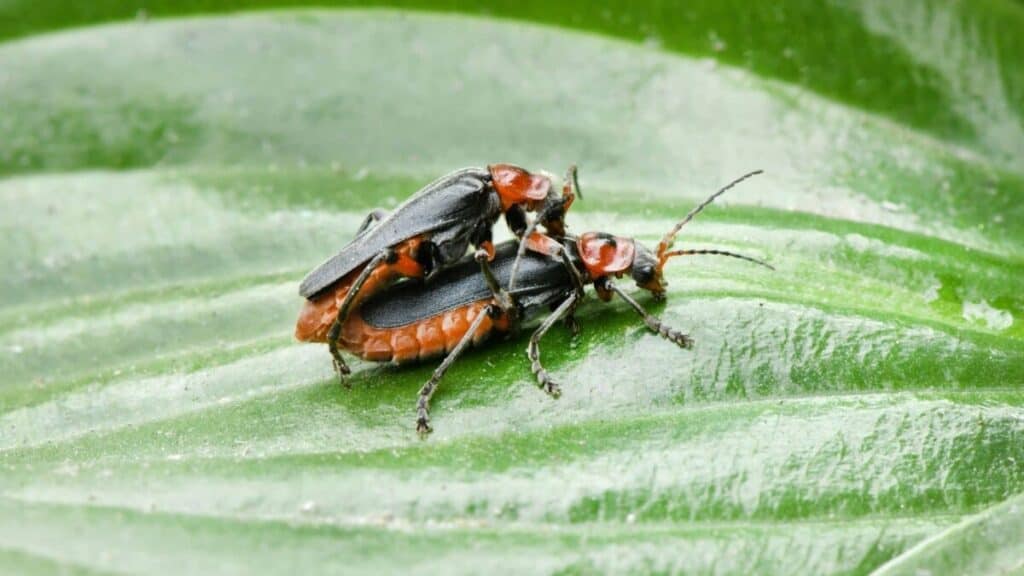
Lastly, we will discuss ways in which they can be eradicated without damage to your household members and/or pets.
Some Specific Types of Beetles are Discussed Elsewhere
In supporting articles, we have provided more detailed descriptions of, and differences between, six common types of beetles that are found in the bedroom:
- The Larder Beetle, also known as moisture beetle (Dermestes Lardarius)
- The Drugstore Beetle, also known as the bread or biscuit beetle (Stegobium paniceum)
- The Cigarette Beetle (Lasioderma serricorne)
- The Spider Beetle (Ptininae family)
- The Red Flour Beetle (Tribolium castaneum) and the Confused Flour Beetle (Tribolium confusum)
- The Carpet Beetle (Anthrenus verbasci)
Here, we will focus on many of the common characteristics across the above species, plus some others that tend to be frequent “visitors” to the house.
General Traits – the Adults vs. the Larvae
For many beetle species, there are differences in behavior and destructive capabilities between the adults and the larvae.
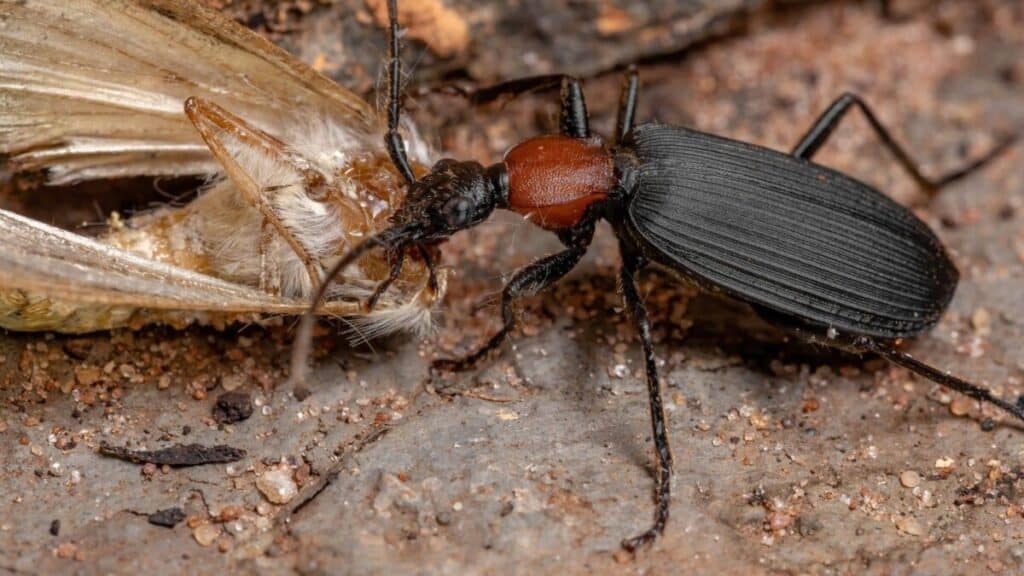
The larvae can be bigger in size, and some of them (e.g., larder beetle and carpet beetle larvae) are covered in fine hairs (cilia) that are the source of allergic reactions, skin rashes and welts if they crawl around on the bed.
Moreover, even if they do not come into direct contact with humans, most larvae fulfill one function well – pretty much eat around the clock.
Therefore, they tend to cause more destruction as the families multiply.
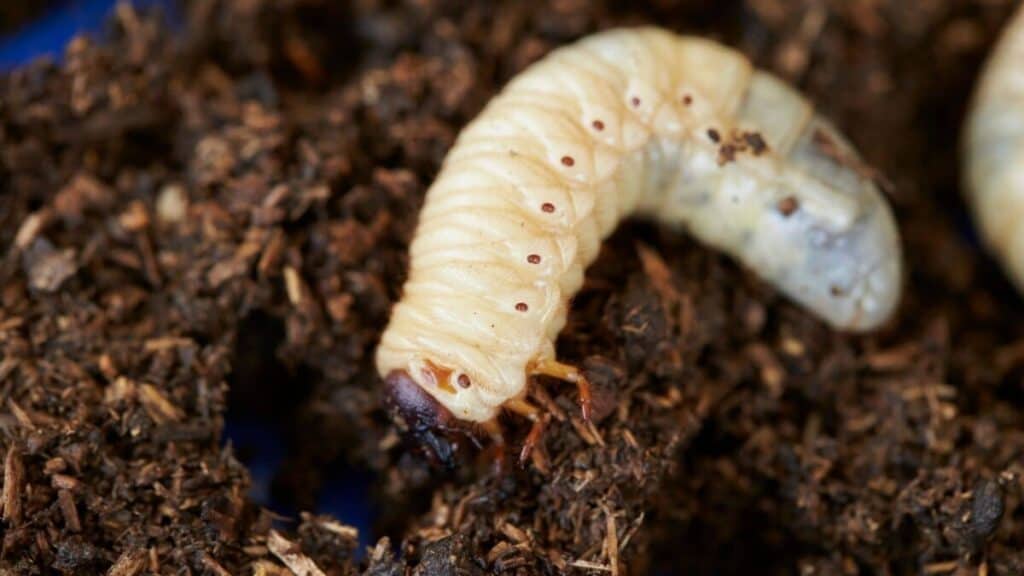
Another big difference in food habits is that adult beetles can often survive in the wild on pollen and nectar, but larvae thrive on food that is found in and near human households.
So, what do your visitors typically dine on?
General Traits – Food Habits and Habitats for Adult Beetles
In general, adult beetles can survive on food they find in the wild, including but not limited to pollen, nectar, rotten flesh, berries and sources of protein.
In fact, some types of adult beetles prefer to stay outside, such as the carpet beetles.
So, why do they move indoors?

Beetles Migrate in Search of Mates and to Nest
Beetles like a few things in and around their habitat, such as:
- Food sources
- Warmth
- Moisture, and
- Alternative areas to forage
In most cases, even beetles that enjoy being outdoors will come inside in search of mates and to set up nests.
The thing that is problematic for us humans is that all the beetles that arrive at the house have evolved to eat an amazing variety of food and non-food items found around our homes, as we discuss in the next section.
Therefore, once they start reproducing and the larvae start eating, they will likely never leave of their own volition.
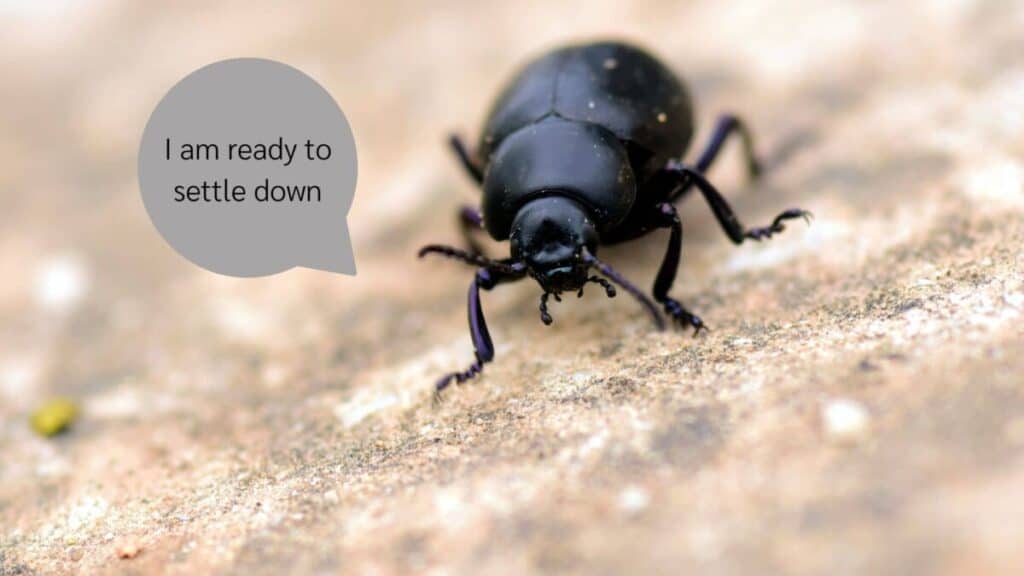
Another thing that tends to drive beetles indoor is the weather. During winter months, they will gravitate indoors in search of warmth and humidity.
How to Beetles Arrive in Your Bedroom?
Beetles can come in by many means. Besides being natural foragers in general, many (though not all) of the species mentioned are strong fliers.
They are often attracted by light – which they equate with food, warmth and nesting possibilities – and will come in through various points, such as door jambs, windows, cracks in the walls or foundations etc.
Another, and often ignored, way that beetles arrive is through packaged or unpackaged food items, whether they be from grocery stores or wholesalers.
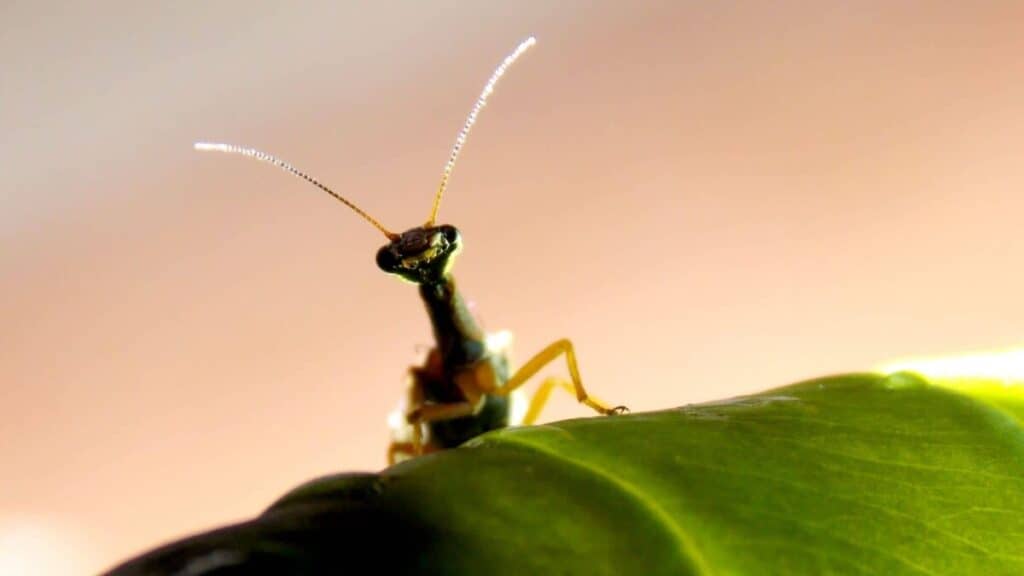
Beetles that feed on grain and other foodstuff have an amazing ability to tear through packaging – even strong material like plastic – to get at food.
The larvae are more persistent than the adults, and some of them spend their entire larval life inside the food source, eating at will.
In addition to beetles that thrive outdoors, there are others that need to be around human food – for example, the larder beetle or the red flour beetle are “stored grain pests”, as we describe in the next section.
So, they have a natural propensity to be around warehouses, food processing plants and yes, your house.
Once inside the house, beetles can start out from the pantry or kitchen area. But given their tendency to forage, the lighted bedroom often attracts them.
As we will see next, there are an amazing variety of foods that they can partake once in there.
Beetles in Your Bedroom can Thrive on an Amazing Variety of “Foods”
While adults can survive on wilderness fare, each of the “household” species have developed the ability to thrive on what they find indoors.
The most common food sources include flour, bread, cookies, cereal, pasta, spices, dried fruit, pet food … so on and so forth.
Many species such as the larder beetle, the flour beetles and the drugstore beetle will thrive on crumbs left around the bedroom.
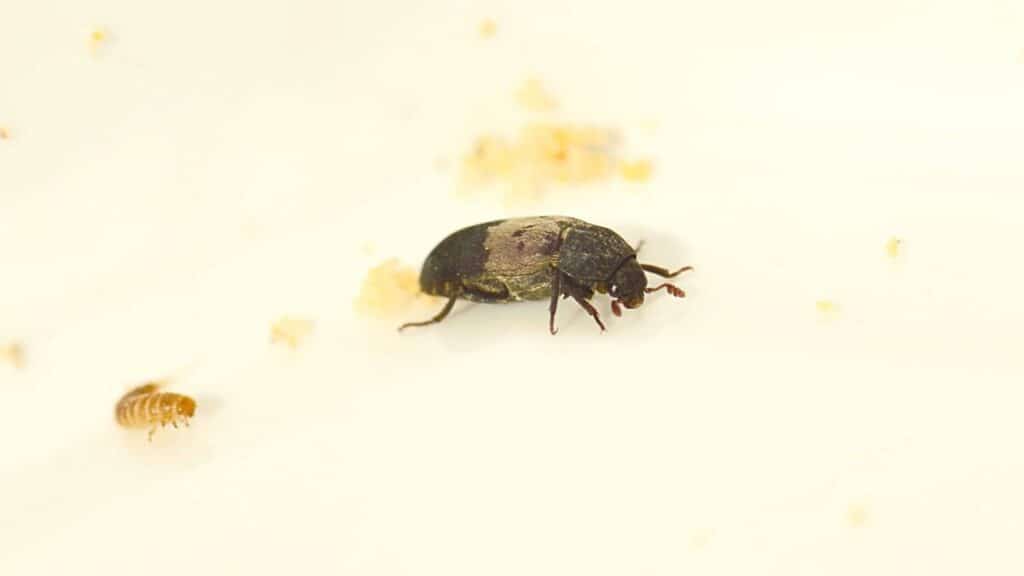
However, there are some other foods that bring certain beetles closer to humans. Most beetles that can show up in your bedroom can go one of three ways in search of food:
- Many species (e.g., spider, drugstore, cigarette and larder beetles) happily feed on silks, books, fabric etc. The carpet beetle is even more destructive, since it eats up carpeting, furs, upholstery and bed linen among other things.
- Several species have extremely specialized taste. For example, the drugstore beetle (as its name suggests) will raid your medicine cabinet for herbal extracts and prescription drugs, or chomp on dried flowers. The cigarette beetle will get into cigarettes, cigars, chewing tobacco and dried tobacco leaves – they will occasionally chew through furniture. The spider beetle, which often starts from the attic, savors bat guano!
- Many of the beetle species will also get into animal products. In the wild, this may be dead insects, but once inside, they will go for leather, hair, hides, flecks of skin, taxidermized specimens etc. – all the way to rotting flesh and spoilt meat. Carpet beetles and larder beetles are prime examples of this.
- Lastly, there are some extremely odd food habits, such as cigarette beetles thriving on pyrethrum powder, a toxin used to kill roaches and other pests.
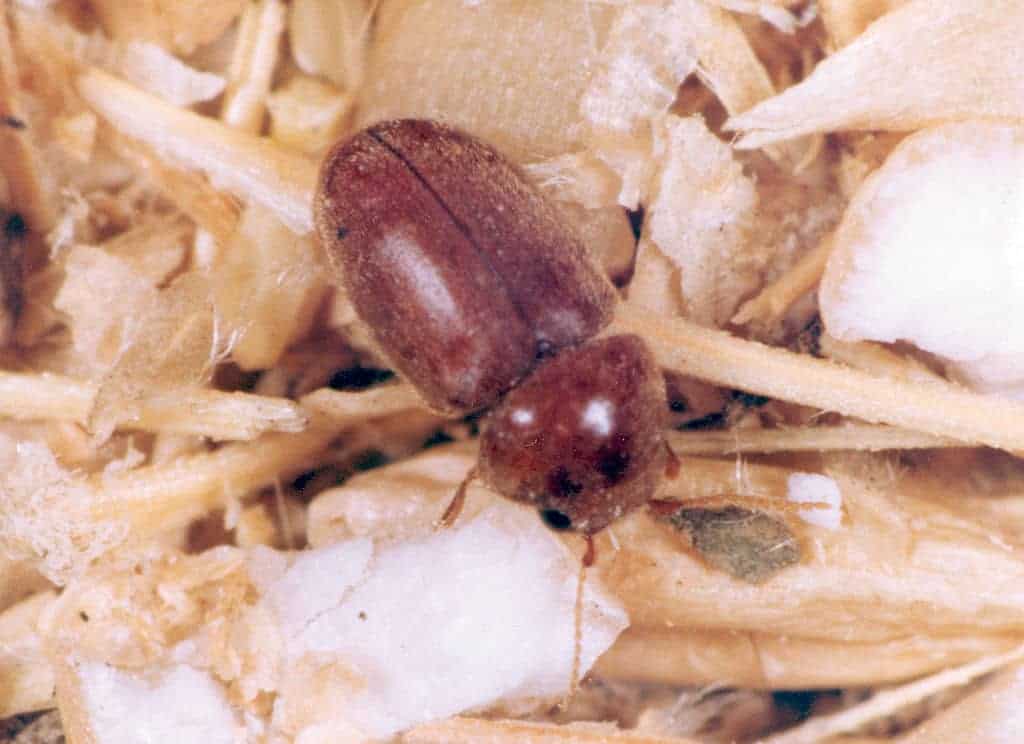
Given the above, plus the fact that the larvae tend to hang around food sources once they find some, one can understand why beetles can make themselves comfortable inside the house and also why, in some cases, they can come into close contact with the occupants of the bed (that’s you, in case there’s any confusion) while you are sleeping.
For example, the hair covered larvae of the carpet or larder beetle will leave their tell-tale signs on your body.
Confusing Beetles with Bed Bugs is Common
Many homeowners may confuse an infestation of some beetles in the bedroom with bed bugs. While there may be reasons for this, but a little digging can help reveal the truth.
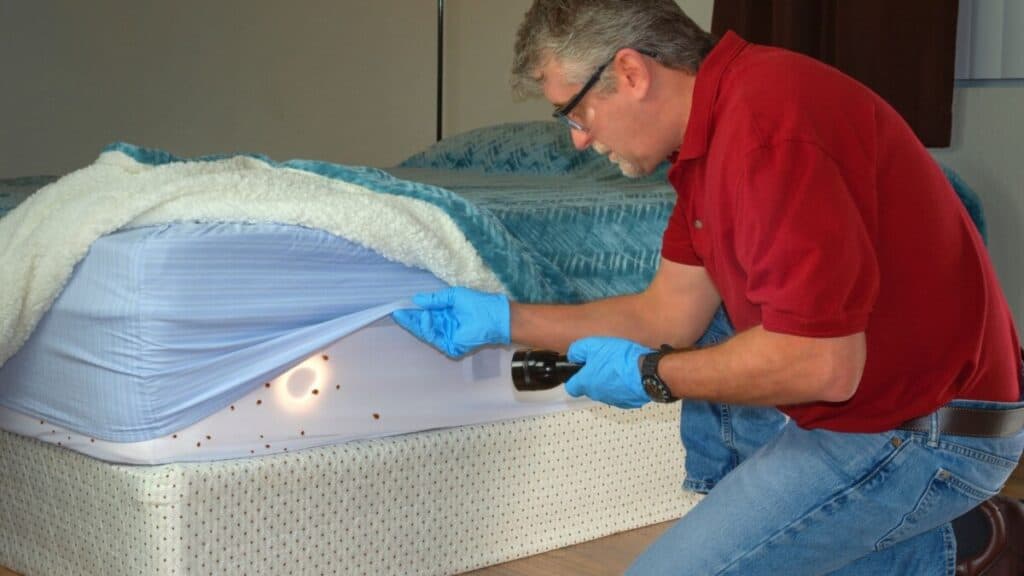
First, here are possible reasons behind the confusion:
- If you are looking for telltale signs in and around the bed, the most obvious one is where you wake up with welts, “bite” marks and other signs of (often bloody) skin irritation. However, you need to look deeper.
- Certain types of beetles live closer to the bed than the others. But when they, or often times their larvae, are strolling around the surface of the bed at night, you are likely asleep.
- Even if you spot one under light, its difficult to tell the tiny insects apart. While red flour beetles, for example, are distinctly different in color and spider beetles look very different under magnification, there are a number of “bedroom resident” beetles that look oval and brown like bedbugs do.
To address the problem properly, a few things must be understood:
- Bed bugs (genus Cimex) feed on human blood, beetles do not (there are some extreme cases, but too few to be relevant). So, beetles do not bite, bed bugs do!
- The welts and irritations come from contact with cilia and appendages used by the beetles and their larvae to forage for food – some of which (e.g. hair or flecks of skin) are being produced by sleeping humans.
- If you have bedbugs, shaking out the bed linens and/or turning over the mattresses will bring them out in droves. Neither beetles nor their larvae, on the other hand, typically live within the bed linens unless they belong to a species (e.g., carpet beetles) that actively feed on them. They are more likely to reside in cracks of the wall, floor boards and bed frames. Even the carpet beetle is much more likely to be found under the carpet than among the bed linen.
- While they do not bite, beetles and their larvae can do substantial damage around the pantry and the bedroom. The impact spreads from producing a bad odor as they infest foods (like flour bins) and die within, to damage to packaging, clothing, linens, upholstery and the like. That cannot be attributed to bed bugs.
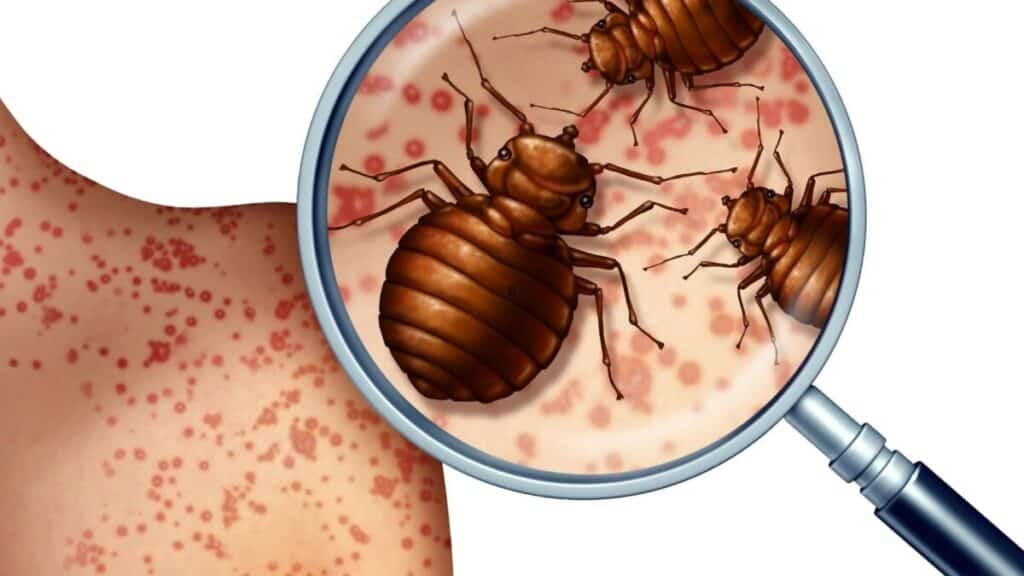
Bottom line, any specialist doctor can discern the root cause of the marks on the body, just like a specialist exterminator will be able to distinguish between a beetle and a bed bug.
Once Inside, Beetles will Multiply Really, Really Fast
Beetle colonies can grow and prosper in a remarkably short period of time. For many species, including the ones mentioned above, the population grows by two or three generations in a calendar year. The table below lists some examples.
| Type | Eggs to Adult Life Timespan | Generations Per Yr.* |
| Carpet | ~ ten months to two+ years | Three to Four |
| Cigarette | ~ 7-10 weeks | Five to Six |
| Drugstore | ~ 6-8 weeks | One |
| Flour | ~ 7 weeks | Four to Five |
| Larder | ~ 6-8 weeks | One to Two |
| Spider | ~ 9-12 weeks | Two to Four |
*: The reproduction rates shown are in warm climates, could be half or less in cold climates.
As the table shows, each of the six species can multiply rapidly and they are likely to take over the area of the house they are in over the course of a few months.
In most cases, females will lay up to a hundred eggs in their lifetime, if not more.
It is to be noted that while the time period varies between the eggs being laid, and then the beetles moving through the larva and pupa stage to adulthoods, the larva often cause the most damage.
For example, in the case of the carpet beetle, though the beetle goes through its stages of life over as long as two years, very little of that time (possibly as little as a few weeks) is spent as an adult.
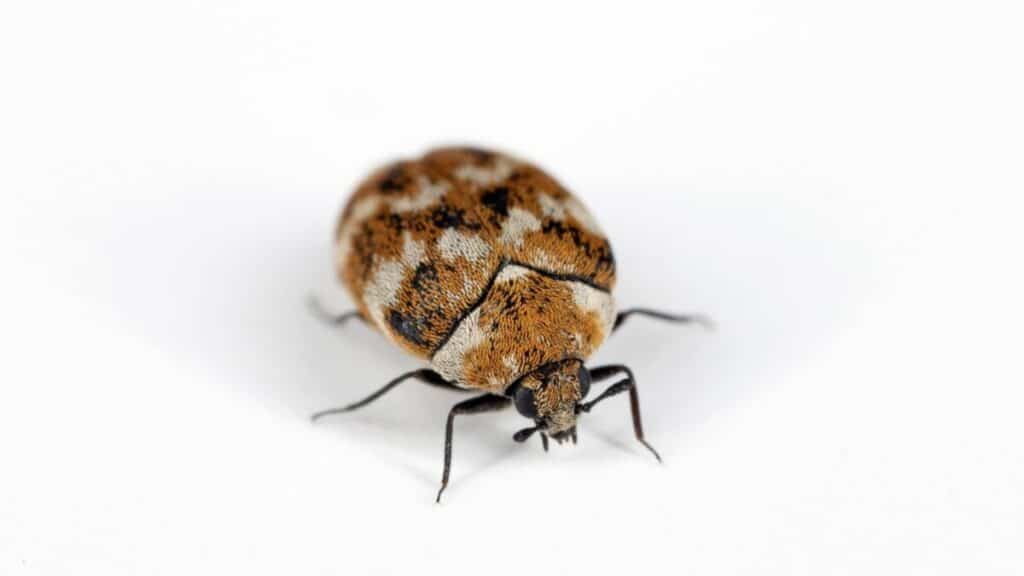
This is not good news for us, since the larval stage lasts much longer.
Due to the difficulty in spotting them and/or noticing telltale effects of a growing army of beetles in the bedroom, it is more likely than not that by the time you begin to pay attention, the problem is already severe.
Tips on How to Contain and/or Eradicate an Infestation
While DYI may not be the way to go in the case of a severe infestation, especially given how fast beetle colonies will multiply if left unchecked, there are some general do’s and don’ts that can work with most of the species that end up in your bedroom.
These are mostly measures that stand out when you understand the characteristics of these species and some common sense prevention and/or eradication mechanisms.
First, something to be avoided. Using commonly used chemical pesticides for beetles that come into the bedroom can be counterproductive and may even be dangerous to you and your pets.
As we described above, there are some beetles that actually feed and thrive on highly toxic pesticides such as pyrethrum powder.
On the other hand, if your kids or a pet happens to come into contact with some, the experience will likely prove traumatic.
There are some beetles that respond to bio-pesticides.

Various DIY sites will also recommend spraying insecticides such as cyfluthrin, permethrin, resmethrin, or tetramethrin into cracks, crevices etc. – but this is dangerous in and around the bedroom especially.
Some Standard Measures Will Definitely Help in Controlling Beetles
Here are some standard measures that can help contain beetles in the home and bedroom:
- Be careful when you unload or otherwise bring in packages containing food – this is one of the prime ways for beetles to get into the house. Unfortunately, this is easier said than done, but inspecting packages or throwing out recently opened ones if you see any signs of beetles would be reasonable steps.
- Keep the home clean and regularly vacuumed, especially around the pantry and food storage areas. Try not to leave food unattended on kitchen counters or bedside tables, empty out pet food dishes and trash containers regularly.
- Store all food in containers that can be tightly locked and preferably vacuum sealed, making it difficult for beetles or their larvae to have access to them.
- Keep the humidity down by using de-humidifiers, especially in the bedroom and living areas.
- Try not to turn on the heat too high. There is, however, a variation of this, called the temperature treatment. Beetles can usually survive in a comfortable range. With flour beetles, for example, putting infected food in an oven for 30-45 minutes with the temperature cranked up between 125-140°F (52-60°C), or putting it in a freezer at 0°F (-18°C) will likely kill off the pests, regardless of their stage of development.
- Check regularly for signs of damage.
While these common sense remedies are possible, a severe infestation is best dealt with through consultation with a professional.

The Final Word
Beetles in your bedroom are not a trivial problem. As we have outlined painstakingly above, many species of beetles – while they can survive in the wilderness – have a propensity to gravitate towards homes as they search for warmth, comfort and opportunities to find new mates and nest.
Then there are other species who have evolved to survive on primarily human foods such as flour and grain based products.
Either way, once beetles get inside your house, there will be a tendency to move out from the pantry into the bedroom.
And once there, there are too many goodies for the adults and their larvae. Due to the range of eating habits some of these species have developed, their sources of food go well beyond human comestibles.
They can devour anything from carpets to silk to books … even tobacco products and medicine.
Once an inspection is identified, its best not to sit around but take action. Given how fast they grow, and the fact that the larvae are even more potent at damage, consult a professional.
Check out our other articles for tips on some specific beetle species that may come by your bedroom.
Alright, that’s it for this article, here are a few hand-selected articles that you might also find interesting reads:
Why Am I Finding Beetles In My House?What Bug Looks Like a Black Dot?
How To Stop Bugs Coming In the Window At Night (Easy Checklist)
Recent Posts
Tiny Black Bugs in Bathroom NO WINGS: What They Are and What to Do!
Finding tiny black bugs in your bathroom can be uncomfortable, to say the least. Especially if they are persistent, or they appear in very large numbers, which they often like to do. When it...
Tiny Black Bugs in Plant Soil - What Are They & What To Do About It
A short horror story: You get a new houseplant. You do your best to take care of it. You’ve ensured that it has the right soil, the right amount of sun, it gets enough water. And then one day, you...

